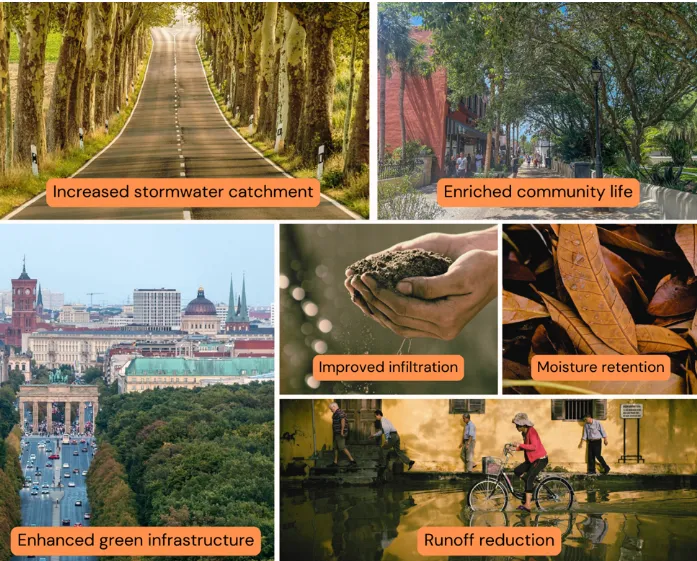Urban Trees and Their Role in Stormwater Management

Urban tree canopies (UTCs), i.e, the layers of leaves, branches, and stems that cover the ground in cities, are essential tools in managing stormwater, particularly in dense urban areas like those across Southern California. In landscapes dominated by impermeable surfaces such as pavements and rooftops, trees serve as natural infrastructure that intercepts rainfall, reduces surface runoff, promotes infiltration, and helps filter pollutants before they reach storm drains and waterways. This not only eases the burden on traditional stormwater systems but also helps reduce flooding, improve water quality, and support climate resilience. Investing in urban trees can make green stormwater infrastructure more accessible and equitable, especially in underserved communities that often lack both canopy cover and adequate drainage. While urban trees also offer benefits such as reducing heat, improving air quality, and supporting biodiversity, this post will focus on their critical role in stormwater management. We will highlight local examples of success and share practical strategies for cities and agencies to expand and maintain their tree canopies as part of a more integrated, sustainable water management approach.
How Do Trees Contribute to Stormwater Management?
When rainfall occurs, trees can help manage stormwater by using their leaves and stem surfaces to intercept any rain before it hits the ground. This process is known as interception and makes use of a tree’s umbrella-like characteristics to increase the surface area of stormwater catchment and allow captured water more time to experience evapotranspiration and/or soil infiltration; 2 other mechanisms of effective stormwater management. Water storing capacity and filtering capabilities of urban trees can significantly reduce the volume of stormwater runoff and runoff pollution occurring in neighborhoods without trees (How Trees Can Retain Stormwater Runoff). In fact, a single tree can store over 100 gallons of water and combining trees with natural landscaping can reduce storm runoff by up to 65% (Trees Tame Stormwater).
Benefits of Urban Tree Canopies for Reducing Runoff and Improving Water Quality
- Rainfall Interception: Tree canopies intercept rain before it hits the ground, reducing the volume and speed of runoff. This delay allows more water to evaporate or be absorbed by surrounding vegetation and soils.
- Infiltration Enhancement: Tree roots help loosen and aerate soil, increasing its capacity to absorb water. This reduces surface runoff and promotes groundwater recharge.
- Pollution Filtration: Trees and the soil around them act as natural filters, capturing and breaking down pollutants such as heavy metals, nutrients, and sediments that would otherwise enter storm drains and waterways.
- Reduced Erosion: By stabilizing soils and slowing runoff, trees help prevent erosion, especially on slopes and along streambanks.
- Stormwater System Relief: By managing water at the source, urban trees reduce the burden on stormwater infrastructure, lowering the risk of system overflow and water treatment costs.
Challenges of Maintaining Urban Tree Canopies
Urban areas tend to be densely populated with buildings, roads, and other infrastructure that can limit the amount of space for trees to grow. Moreover, the soils within urban landscapes are often compacted by construction and heavy foot traffic, further inhibiting root growth and nutrient uptake. Many cities, unfortunately, lack adequate funding and resources for proper tree selection and maintenance, which can hinder the long-term health of urban tree canopies. Choosing a location for UTC installation requires much preparation and research beforehand as failing to do so can lead to unsustainable competition for water, sunlight, and nutrients amongst neighboring vegetation. Most urban trees in California cities are medium water users with reduced drought resilience based on historical planting patterns (California State Water Resources Control Board). The careful consideration of local ordinances and development density is crucial for efficiently balancing the needs of municipalities and private homeowners with the health of urban trees.
Successful Urban Forestry Initiatives in Southern California
The concept of urban tree canopies is sometimes referred to as “green infrastructure”, which is defined as an “interconnected network of green space that conserves natural ecosystem values and functions” providing social, psychological, recreational, and economic benefits to human populations (Benedict and McMahon 2002; Nowak et al., 2010). Understanding the history behind urban forests can help inform the management decisions of today. Here are a few examples of successful urban forestry initiatives within Southern California that are producing healthy, vibrant canopies at both the county and city levels.
USC Trees: The University of Southern California’s Urban Trees Initiative connects faculty, staff, and student researchers with community members and local policymakers to advance climate resilient urban forestry practices and equitable green space distribution.
The California Strategic Plan for Urban Forestry: In partnership with Cal Fire and driven by Assembly Bill 2251, Cal Poly will lead a new project focusing on boosting canopy cover by 10% by 2035 in efforts to address climate change, create healthier communities, and enhance green space access equity.
Let’s GREEN Riverside: For almost 50 years now, SoCal environmental nonprofit organization, TreePeople, has partnered with countless communities across Southern California to plant over 3 million trees. They are continuing their mission in the Inland Empire by working to plant 1,000 street trees and distribute 1,000 fruit/shade trees for residents to plant at their homes.
OurCounty: A regional sustainability plan for Los Angeles organized around 12 goals focusing on enhancing urban environmental safety and equity. One of the goals aims to ensure an equitably distributed, climate-appropriate, healthy urban tree canopy for residents.
Strategies for Increasing Urban Tree Planting and Maintenance
Planning & Policy
Analyzing prior urban forestry management plans is a great way to understand urban tree maintenance needs and costs. It is recommended to include forest canopy targets in city-level strategies and plans and connect local policy to state-level regulations and goals on climate mitigation [Five ways to increase tree cover in cities (commentary)]. Building partnerships between residents and their respective governments can help leverage capacity and improve knowledge and public support for urban forestry.
- Some resources for further urban tree canopy planning and policy include the Council for Watershed Health, California Water Board’s LID in Schools Guidance, and California Stormwater Quality Association’s SoCal LID Manual.
Planting
Be intentional with the specific tree species you wish to plant in your neighborhood. Native plant species are always recommended, but some factors to consider while designing your UTC are heat stress tolerance, drought tolerance, sunlight exposure requirements, pest resistance, root systems, proximity to buildings, soil type/compaction, space needs below and above ground, and water demand (Comprehensive Tree Care Strategies for Urban Environments).
- In efforts to reduce the urban heat islands within the Inland Empire, Janet Hartin, the UC Cooperative Extension advisor for Los Angeles, San Bernardino and Riverside counties, suggested that trees should be selected based on their adaptation to the “micro-climate” of each landscape. Additionally, planting in early fall through late winter provides trees enough time to establish a strong root system before enduring Southern California’s summer heat (Now is the time to plant climate-ready trees, says UCCE researcher).
- You can find good local guidance on tree selection with The Sacramento Tree Foundation, CalPoly's SelecTree Guide, Moon Valley Nurseries, the Theodore Payne Foundation, and the The City of San Diego LID Design Manual.
Maintenance
Proper watering, mulching, and damage prevention practices are key to the longevity of urban trees. Adequate pruning and tree removal practices can also help to ensure long-term tree health and decrease the potential for property damage. Keep records of planting and maintenance to help track progress and identify trends in growth.
- Young trees require more consistent care than an adult urban tree canopy. Community growers should consider hiring certified arborists during the early development of a UTC.
- Unlike newly planted trees, existing shade trees must be watered infrequently, but deeply (at least a depth of 8-10 inches) to encourage root growth and prevent overwatering. Mature trees should be professionally trimmed every 5-10 years to increase tree value, reduce storm damage, and improve overall stability.
Community Involvement & Funding
Municipal decision-makers are encouraged to increase spending on urban tree maintenance to maximize tree health and their indirect benefits to communities. Providing proper training and value to the workforces appointed for healthy UTC maintenance is crucial for efficient cooperation between local forestry and parks departments.
- The California Stormwater Quality Association offers a section on Stormwater Funding in their website with information, links, and references, to guide you in developing sustainable funding for stormwater programs and projects. It was created to assist member agencies and other California municipalities in navigating the complexities behind funding stormwater programs and projects.
- Organizations like California Climate Action Corps and GrizzlyCorps recognize urban tree planting as an efficient best management practice for stormwater management and other environmental benefits.
References
1. “Soak Up the Rain: Trees Help Reduce Runoff.” EPA, Environmental Protection Agency, www.epa.gov. Accessed 23 May 2025.
2. Swann, Chris. “Review of the Available Literature and Data on the Runoff and Pollutant Removal Capabilities of Urban Trees.” Center for Watershed Protection, 28 Dec. 2017, owl.cwp.org.
3. “How Trees Can Retain Stormwater Runoff.” Tree Planting Nonprofit, Arbor Day Foundation, 27 Sept. 2018, www.arborday.org.
4. “Trees Prevent Stormwater Pollution.” The Nature Conservancy, www.nature.org. Accessed 23 May 2025.
5. “Supercharged Hurricanes Are Our New Reality. How Can Trees Help?” Tree Planting Nonprofit, Arbor Day Foundation, 9 Aug. 2023, www.arborday.org.
6. “Stormwater Quantity and Rate Control Benefits of Trees in Uncompacted Soil.” Deeproot.Com, 27 July 2020, www.deeproot.com.
7. “Trees Tame Stormwater.” Tree Planting Nonprofit, Arbor Day Foundation, www.arborday.org. Accessed 23 May 2025.
8. “Avoided Runoff and Urban Forests (U.S. National Park Service).” National Parks Service, U.S. Department of the Interior, www.nps.gov. Accessed 23 May 2025.
9. “Comprehensive Tree Care Strategies for Urban Environments.” Arborist Now, 11 Feb. 2025, www.arboristnow.com.
10. Mukpo, Ashoka, et al. “Five Ways to Increase Tree Cover in Cities (Commentary).” Mongabay Environmental News, 6 July 2023, news.mongabay.com.
11. “Urban Forest Master Plan.” Urban Forest Master Plan | Summerville, SC, www.summervillesc.gov. Accessed 23 May 2025.
12. Katarzyna. “6 Practical Tips for Caring for Trees in Your Neighborhood.” One More Tree Foundation, 19 Mar. 2024, one-more-tree.org.
13. Benedict and McMahon 2002; Nowak et al., 2010
14. Slater, Emily. “Cal Poly to Lead Development of California’s New Urban Forestry Strategic Plan.” Cal Poly, 3 Dec. 2024, www.calpoly.edu.
15. “Let’s GREEN Riverside.” TreePeople, 3 Apr. 2025, treepeople.org.
16. December 6, 2022. “Now Is the Time to Plant Climate-Ready Trees, Says UCCE Researcher.” UC Agriculture and Natural Resources, 31 Mar. 2025, ucanr.edu.
17. “Shady-80-Trees-Recommended-for-the-Sacramento-Region ...” The Sacramento Tree Foundation, sactree.org. Accessed 23 May 2025.
About the Authors

Daniel Gonzalez II is an associate research and extension specialist at SCREC under the Grizzly Corps Fellowship Program. He focuses on researching and developing nature-based solutions for stormwater management practices in Southern California. Drawing from his background as a certified K-12 educator, Daniel is excited to make watershed and climate-resilient resources more accessible for local communities across Southern California.
Contact at dgonzalezll@berkeley.edu

Dr. Esther N Lofton is an Urban Watershed Resilience Advisor serving Orange, Los Angeles, San Bernardino, and Riverside Counties. She focuses on drinking and environmental water quality, water use efficiency, water supply security, and water equity. Her research is conducted at various scales, such as surface and ground water basins, watersheds, neighborhoods, and field or household scales. Her research is geared towards providing recommendations and guidance to stakeholders such as watershed and stormwater managers, policy makers, and the public to make better decisions on water resources management.
Contact at enmosase@ucanr.edu or (858) 282-6737

Dr. Erik Porse is the Director of the California Institute for Water Resources and an Associate Cooperative Extension Specialist within the University of California Division of Agriculture and Natural Resources (UC ANR). Erik is an engineer, environmental scientist, and policy analyst who focuses on water and environmental management. Since 2011, Erik's work in California has included studies on safe drinking water, efficient urban water use, sustainable groundwater management, water reuse, beneficial uses of stormwater, environmental finance, and water resource systems analysis.
Contact at eporse@ucanr.edu or (530) 240-2612
